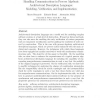Free Online Productivity Tools
i2Speak
i2Symbol
i2OCR
iTex2Img
iWeb2Print
iWeb2Shot
i2Type
iPdf2Split
iPdf2Merge
i2Bopomofo
i2Arabic
i2Style
i2Image
i2PDF
iLatex2Rtf
Sci2ools
JSS
2010
2010
Handling communications in process algebraic architectural description languages: Modeling, verification, and implementation
Architectural description languages are a useful tool for modeling complex systems at a high level of abstraction. If based on formal methods, they can also serve for enabling the early verification of various properties such as component coordination and for guiding the synthesis of code correct by construction. This is the case with process algebraic architectural description languages, which are process calculi enhanced with the main architectural concepts. However, the techniques with which those languages have been equipped are mainly conceived to work with synchronous communications only. The objective of this paper is threefold. On the modeling side, we show how to enhance the expressiveness of a typical process algebraic architectural description language by including the capability of representing nonsynchronous communications in such a way that the usability of the original language is preserved. On the verification side, we show how to modify techniques for analyzing the ab...
Algebraic Architectural Description | Architectural Description Languages | JSS 2010 | Nonsynchronous Communications |
| Added | 19 May 2011 |
| Updated | 19 May 2011 |
| Type | Journal |
| Year | 2010 |
| Where | JSS |
| Authors | Marco Bernardo, Edoardo Bontà, Alessandro Aldini |
Comments (0)

